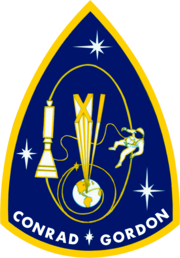Gemini 11

Gemini XI conducting a tether experiment using the Agena Target Vehicle
|
|
| Operator | NASA |
|---|---|
| COSPAR ID | 1966-081A |
| SATCAT № | 2415 |
| Mission duration | 2 days, 23 hours, 17 minutes, 9 seconds |
| Orbits completed | 44 |
| Spacecraft properties | |
| Spacecraft | Gemini SC11 |
| Manufacturer | McDonnell |
| Launch mass | 3,798 kilograms (8,374 lb) |
| Landing mass | 1,920 kilograms (4,230 lb) |
| Crew | |
| Crew size | 2 |
| Members |
Charles "Pete" Conrad, Jr. Richard F. Gordon Jr. |
| EVAs | 2 |
| Start of mission | |
| Launch date | September 12, 1966, 14:42:26 UTC |
| Rocket | Titan II GLV, |
| Launch site | Cape Kennedy LC-19 |
| End of mission | |
| Recovered by | USS Guam |
| Landing date | September 15, 1966, 13:59:35 UTC |
| Landing site | 24°15.4′N 70°0′W / 24.2567°N 70.000°W |
| Orbital parameters | |
| Reference system | Geocentric |
| Regime | Low Earth orbit |
| Perigee | 298 kilometers (161 nmi) |
| Apogee | 1,368 kilometers (739 nmi) |
| Inclination | 28.8 degrees |
| Period | 101.57 minutes |
| Epoch | September 14, 1966 |
| Docking with GATV-5006 | |
| Docking date | September 12, 1966, 16:16:00 UTC |
| Undocking date | September 14, 1966, 16:55:00 UTC |
| Time docked | 2 days, 39 minutes |
 (Left to Right) Gordon & Conrad |
|
Gemini 11 (officially Gemini XI)) was the ninth manned spaceflight mission of NASA's Project Gemini, which flew from September 12 to 15, 1966. It was the 17th manned American flight and the 25th spaceflight to that time (includes X-15 flights over 100 kilometers (54 nmi)). Astronauts Charles "Pete" Conrad, Jr. and Richard F. Gordon Jr. performed the first-ever direct-ascent (first orbit) rendezvous with an Agena Target Vehicle, docking with it one hour and thirty-four minutes after launch; used the Agena rocket engine to achieve a world record high-apogee earth orbit; and created a small amount of artificial gravity by spinning the two spacecraft connected by a tether. Gordon also performed two extra-vehicular activities for a total of 2 hours and 41 minutes.
Highest orbit (followed twice):
The direct-ascent rendezvous and docking with the Agena vehicle was achieved approximately 94 minutes after lift-off, depending on the on-board computer and radar equipment with only minimal assistance from ground support.
Gemini 11 used the rocket on its Agena target vehicle to raise its apogee to 850 miles (1,370 km), the highest Earth orbit ever reached by a manned spacecraft. The perigee was 179 miles (288 km), and maximum velocity (at perigee) was 17,967 miles per hour (28,915 km/h). The apogee record stands as of March 2016, even though men have achieved greater distances from Earth by flying to the Moon in the Apollo program. The maximum operational altitude of the Space Shuttle was lower, at 600 miles (970 km).
...
Wikipedia

